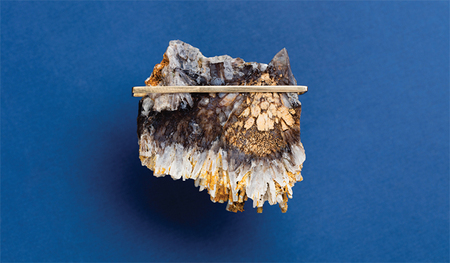
Almost exactly a decade before Christodoulos Panayiotou opened his recent show “False Form,” the Cypriot artist convened a roundtable at the University of Oxford among an astrophysicist, a historian of antiquity, a philosopher, and an artist, Jem Finer, on the theme of absence. The antiquarian introduced negative theology as a way to think beyond reason; thus the Christian tradition, she explained, asks questions relating to what God is not.
The notable sparseness of “False Form,” with its five unwrapped panels—their gilt edges showing—stacked facing the wall protected by U-shaped foam profiles while another hung on the wall, and its small stacks of closed Samsonite boxes atop a hefty red marble table, felt conspiratorially secretive, even alienating. The inward-facing boards bespoke a bluff anti-visual conceptualism, but, looking closer, their Byzantine gilt evoked a deeper history of iconoclasm—further evidence of Panayiotou’s long-standing interest in absence.
Framed, altar-like, on the reverse of the two arches that bisect Rodeo’s top-floor space, a hanging panel faced outward, its image a kind of Byzantine Suprematism, toward a braid-patterned stained-glass window. Back on the other side of the arches, the topmost stacked panel’s verso displayed keyhole slots that, aside from being the fixtures that might hang it on a wall, ask, symbolically, to be unlocked.
The key was the press release, a confiding letter from the artist to Rodeo’s owner and director, Sylvia Kouvali. Panayiotou is an inveterate letter writer: The many he’s published (for instance, to accompany the Cyprus pavilion at the Venice Biennale in 2015) are an important part of his practice; they always include the date and the artist’s location at the time, and are erudite philosophical explications of process, often with biographical details. Writing from Cambridge, UK, on May 8, 2016, he asks: “How do we go beyond forms?”
Inside those Samsonite boxes, which the staff were supposed to open for gallerygoers (nobody offered to show me), are pieces of jewelry, designed by Panayiotou, inset with cut and polished minerals. According to geological nomenclature, these are pseudomorphs, “false forms”: minerals that, as a result of substitution or alteration, have the appearance of other minerals, despite being compositionally different. False form, for Panayiotou, is an end to form, or at least a move beyond form as it is defined by substance. In his letter, Panayiotou frames falsity as a kind of substitution: “Isn’t substitution sublimation in drag?” Absence is replaced by substitution. It’s hard to know specifically how this was intended to play out across all of the works in the show, but it produced a certain ontological queasiness—the same queasiness Panayiotou values in theater (at last year’s Serpentine Galleries–sponsored Park Nights in London he gave a lecture-reading on literal, metaphorical, and symbolic death onstage).
Panayiotou’s oldest memory of theater is of immaculately dressed itinerant jewelers who, black Samsonite briefcases full of gold in hand, hawked their pieces from door to door. “They passed them through their fingers with great virtuosity,” he writes, “weighed them as a proof, described the design with hyperbolic metaphors, made you try them, advanced flatteries and pushed you to buy them.” Choreographing the gallery staff, he directed them in turn, like those traveling jewelers, to perform the act of peddling his jewelry.
Choreography entered “False Form” in other ways: Kouvali was instructed to change the outward-facing panel located between the arches according to her own sense of duration, rhythm, and order. Further, she was to urge every visitor to take a five-minute walk from the gallery’s Charing Cross Road location to the British Museum in Bloomsbury (and, when possible, to accompany them) to view Triumph of Orthodoxy, a fifteenth-century portable icon from the Marmara region in northwest Turkey. Painted in egg tempera with gold leaf on a wooden panel, this late-Byzantine icon shows the restoration of images in Byzantium in 843 after decades of an official ban on icons. The scene takes place on a stage with the curtains drawn; as Panayiotou notes: “Theater and veneration have always been intimately connected.” A nonbeliever, he admits to being fascinated by the theatricality of religious ritual. Taking his choreography out of the gallery and into the street, Panayiotou asserts what endures for him as the sacred in the everyday.
